Financial Analysis Report: Insolvency of ABC, HIH, and One.Tel
VerifiedAdded on 2021/05/30
|10
|2753
|339
Report
AI Summary
This report provides a comprehensive financial analysis of the insolvency of ABC Learning, HIH Insurance, and One.Tel. It explores the factors contributing to their liquidation, including debt repayment issues, mismanagement, and IT strategy failures. The analysis delves into ethical breaches as per the CPA code of conduct and examines corporate governance failures based on ASX rulings. The report also discusses the companies' liabilities prior to their collapse. Key findings highlight the role of auditors, corporate governance non-compliance, and the impact of financial mismanagement. The report concludes by summarizing the primary reasons for the companies' financial downfall, emphasizing the importance of ethical conduct and sound financial practices.
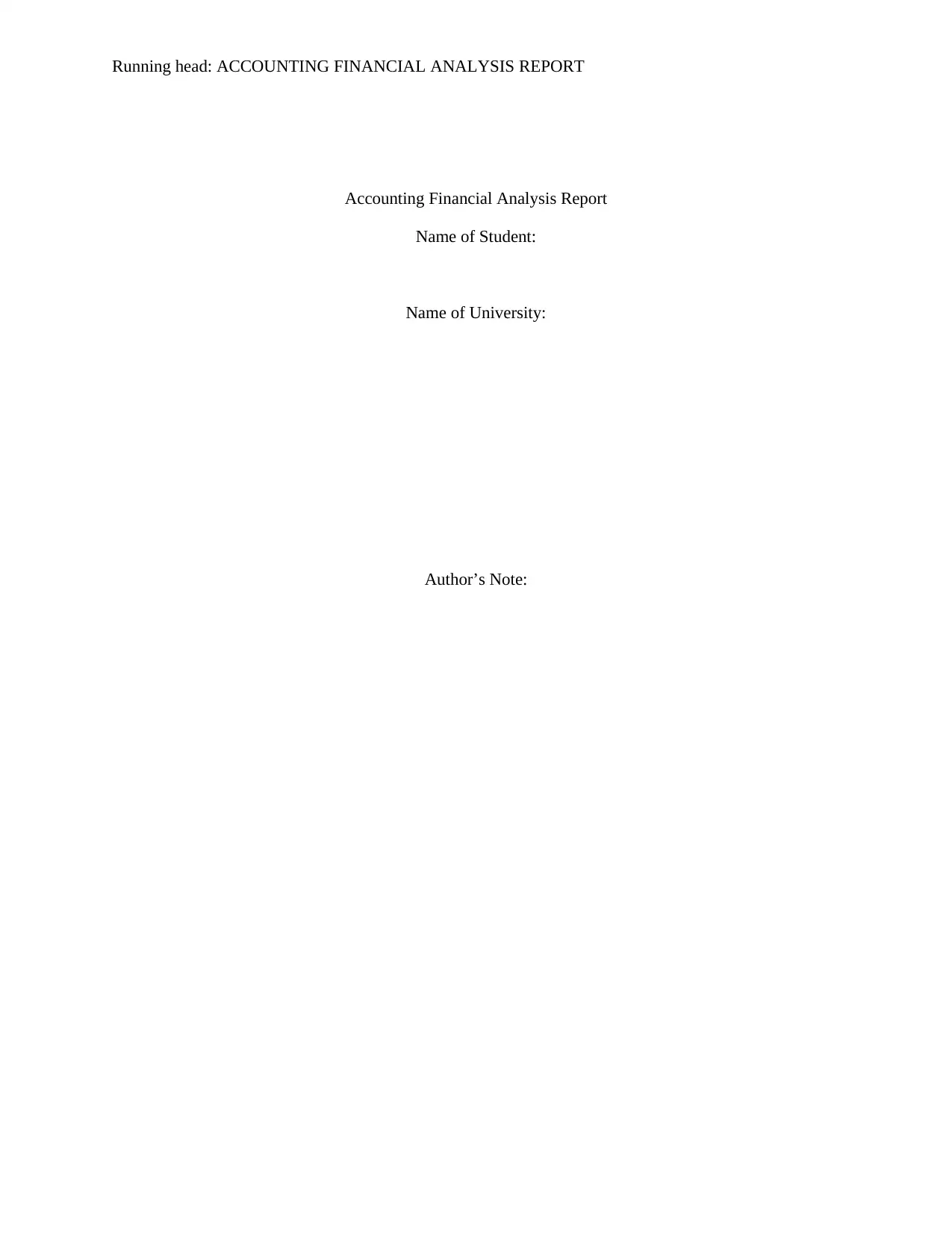
Running head: ACCOUNTING FINANCIAL ANALYSIS REPORT
Accounting Financial Analysis Report
Name of Student:
Name of University:
Author’s Note:
Accounting Financial Analysis Report
Name of Student:
Name of University:
Author’s Note:
Paraphrase This Document
Need a fresh take? Get an instant paraphrase of this document with our AI Paraphraser
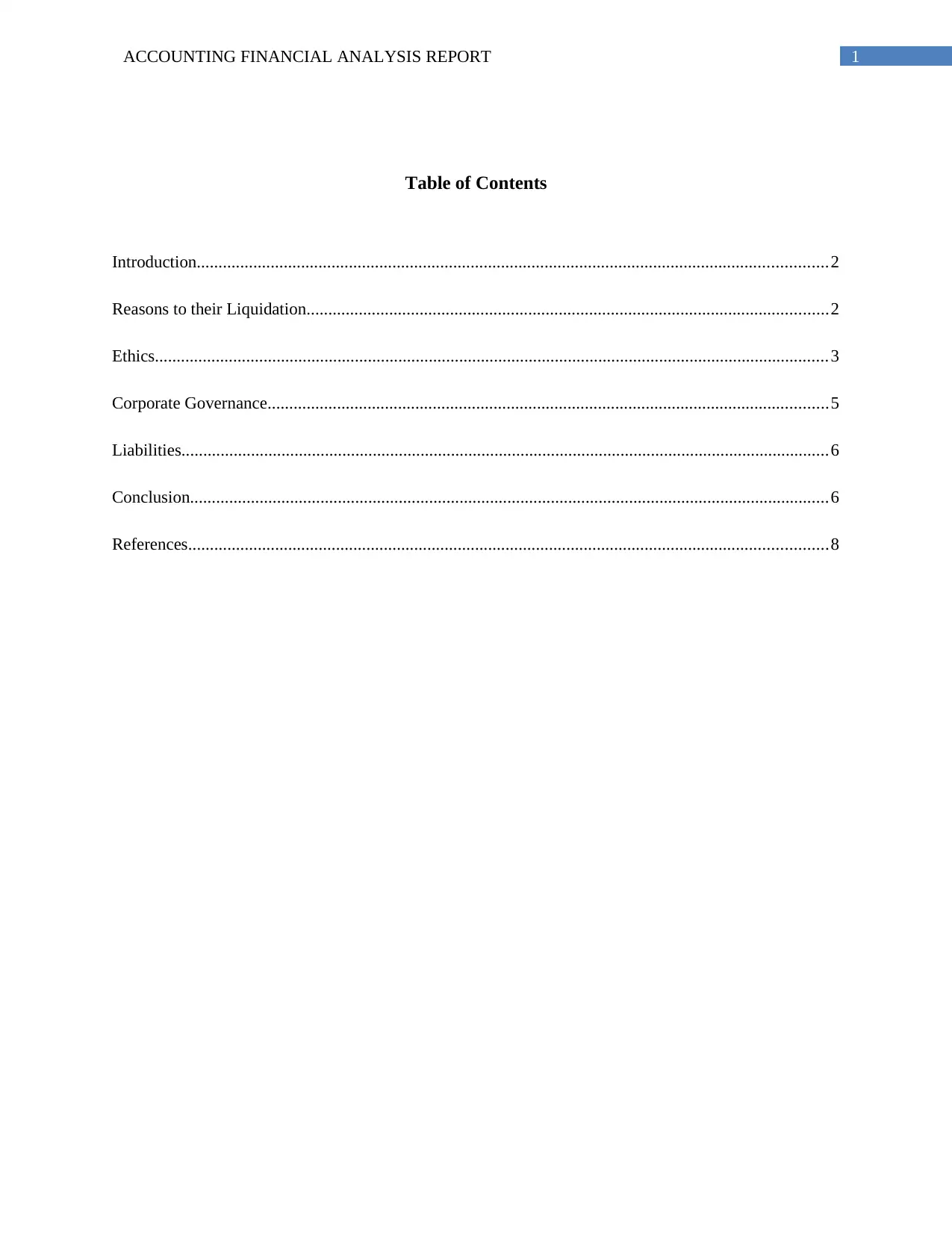
1ACCOUNTING FINANCIAL ANALYSIS REPORT
Table of Contents
Introduction.................................................................................................................................................2
Reasons to their Liquidation........................................................................................................................2
Ethics...........................................................................................................................................................3
Corporate Governance.................................................................................................................................5
Liabilities.....................................................................................................................................................6
Conclusion...................................................................................................................................................6
References...................................................................................................................................................8
Table of Contents
Introduction.................................................................................................................................................2
Reasons to their Liquidation........................................................................................................................2
Ethics...........................................................................................................................................................3
Corporate Governance.................................................................................................................................5
Liabilities.....................................................................................................................................................6
Conclusion...................................................................................................................................................6
References...................................................................................................................................................8
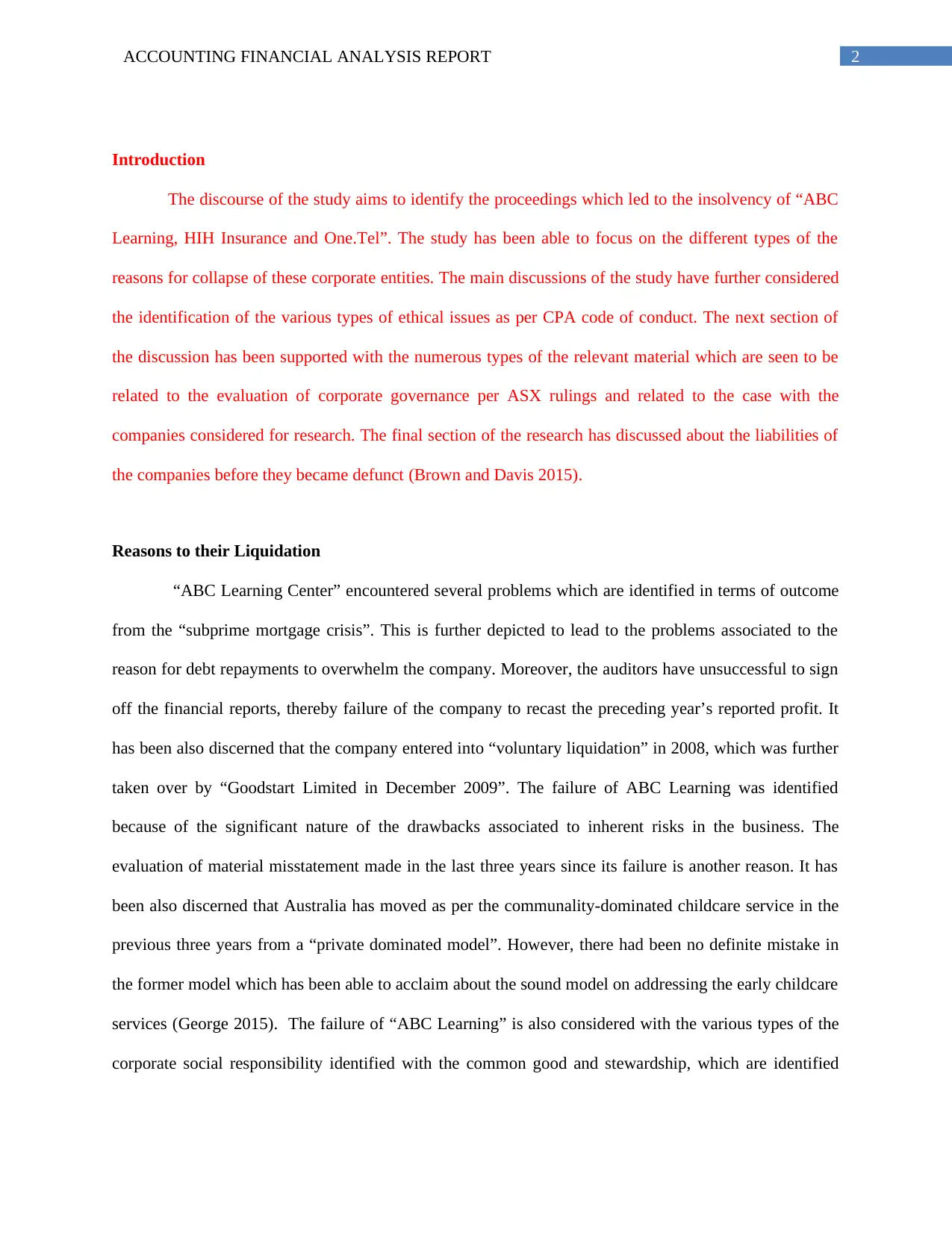
2ACCOUNTING FINANCIAL ANALYSIS REPORT
Introduction
The discourse of the study aims to identify the proceedings which led to the insolvency of “ABC
Learning, HIH Insurance and One.Tel”. The study has been able to focus on the different types of the
reasons for collapse of these corporate entities. The main discussions of the study have further considered
the identification of the various types of ethical issues as per CPA code of conduct. The next section of
the discussion has been supported with the numerous types of the relevant material which are seen to be
related to the evaluation of corporate governance per ASX rulings and related to the case with the
companies considered for research. The final section of the research has discussed about the liabilities of
the companies before they became defunct (Brown and Davis 2015).
Reasons to their Liquidation
“ABC Learning Center” encountered several problems which are identified in terms of outcome
from the “subprime mortgage crisis”. This is further depicted to lead to the problems associated to the
reason for debt repayments to overwhelm the company. Moreover, the auditors have unsuccessful to sign
off the financial reports, thereby failure of the company to recast the preceding year’s reported profit. It
has been also discerned that the company entered into “voluntary liquidation” in 2008, which was further
taken over by “Goodstart Limited in December 2009”. The failure of ABC Learning was identified
because of the significant nature of the drawbacks associated to inherent risks in the business. The
evaluation of material misstatement made in the last three years since its failure is another reason. It has
been also discerned that Australia has moved as per the communality-dominated childcare service in the
previous three years from a “private dominated model”. However, there had been no definite mistake in
the former model which has been able to acclaim about the sound model on addressing the early childcare
services (George 2015). The failure of “ABC Learning” is also considered with the various types of the
corporate social responsibility identified with the common good and stewardship, which are identified
Introduction
The discourse of the study aims to identify the proceedings which led to the insolvency of “ABC
Learning, HIH Insurance and One.Tel”. The study has been able to focus on the different types of the
reasons for collapse of these corporate entities. The main discussions of the study have further considered
the identification of the various types of ethical issues as per CPA code of conduct. The next section of
the discussion has been supported with the numerous types of the relevant material which are seen to be
related to the evaluation of corporate governance per ASX rulings and related to the case with the
companies considered for research. The final section of the research has discussed about the liabilities of
the companies before they became defunct (Brown and Davis 2015).
Reasons to their Liquidation
“ABC Learning Center” encountered several problems which are identified in terms of outcome
from the “subprime mortgage crisis”. This is further depicted to lead to the problems associated to the
reason for debt repayments to overwhelm the company. Moreover, the auditors have unsuccessful to sign
off the financial reports, thereby failure of the company to recast the preceding year’s reported profit. It
has been also discerned that the company entered into “voluntary liquidation” in 2008, which was further
taken over by “Goodstart Limited in December 2009”. The failure of ABC Learning was identified
because of the significant nature of the drawbacks associated to inherent risks in the business. The
evaluation of material misstatement made in the last three years since its failure is another reason. It has
been also discerned that Australia has moved as per the communality-dominated childcare service in the
previous three years from a “private dominated model”. However, there had been no definite mistake in
the former model which has been able to acclaim about the sound model on addressing the early childcare
services (George 2015). The failure of “ABC Learning” is also considered with the various types of the
corporate social responsibility identified with the common good and stewardship, which are identified
⊘ This is a preview!⊘
Do you want full access?
Subscribe today to unlock all pages.

Trusted by 1+ million students worldwide
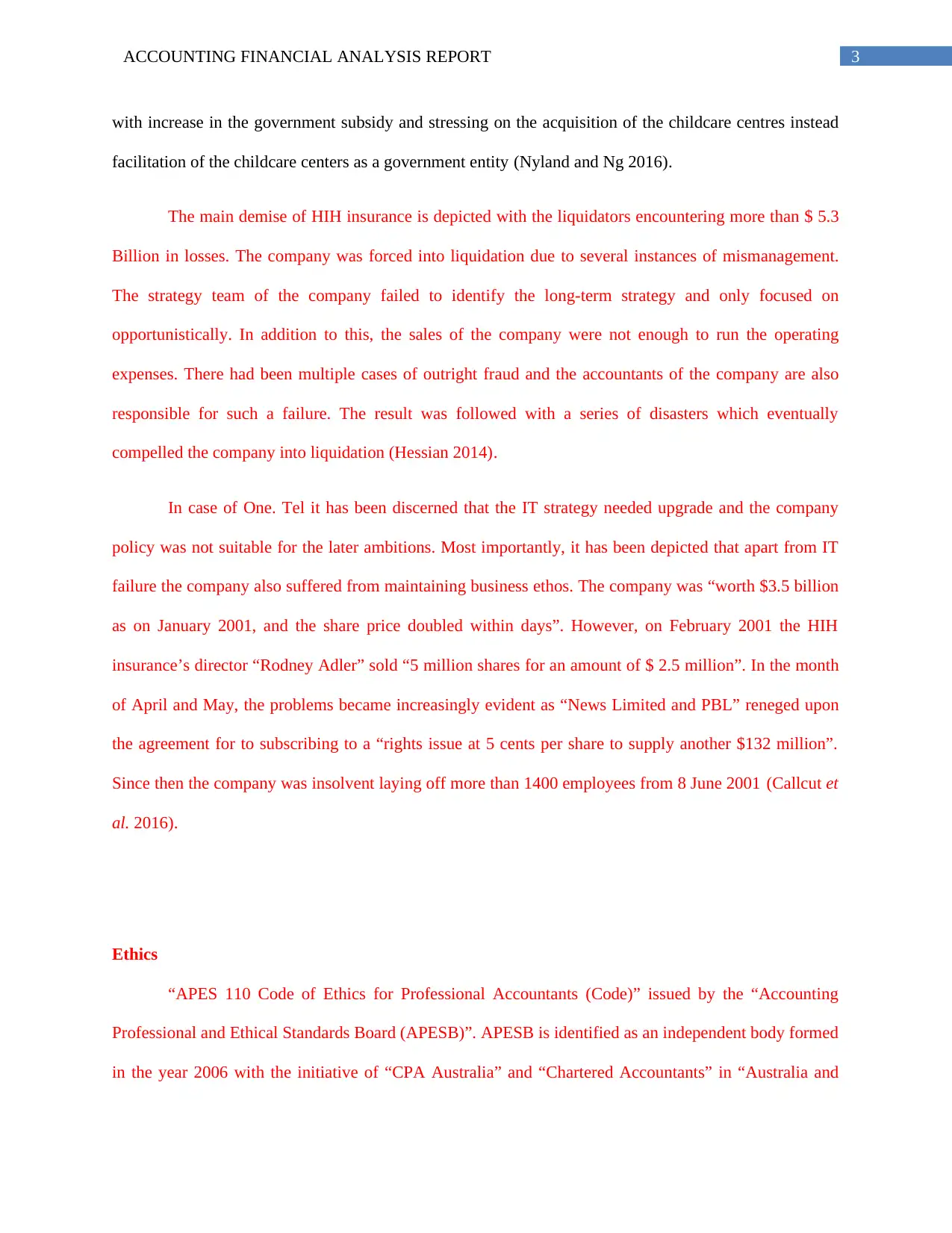
3ACCOUNTING FINANCIAL ANALYSIS REPORT
with increase in the government subsidy and stressing on the acquisition of the childcare centres instead
facilitation of the childcare centers as a government entity (Nyland and Ng 2016).
The main demise of HIH insurance is depicted with the liquidators encountering more than $ 5.3
Billion in losses. The company was forced into liquidation due to several instances of mismanagement.
The strategy team of the company failed to identify the long-term strategy and only focused on
opportunistically. In addition to this, the sales of the company were not enough to run the operating
expenses. There had been multiple cases of outright fraud and the accountants of the company are also
responsible for such a failure. The result was followed with a series of disasters which eventually
compelled the company into liquidation (Hessian 2014).
In case of One. Tel it has been discerned that the IT strategy needed upgrade and the company
policy was not suitable for the later ambitions. Most importantly, it has been depicted that apart from IT
failure the company also suffered from maintaining business ethos. The company was “worth $3.5 billion
as on January 2001, and the share price doubled within days”. However, on February 2001 the HIH
insurance’s director “Rodney Adler” sold “5 million shares for an amount of $ 2.5 million”. In the month
of April and May, the problems became increasingly evident as “News Limited and PBL” reneged upon
the agreement for to subscribing to a “rights issue at 5 cents per share to supply another $132 million”.
Since then the company was insolvent laying off more than 1400 employees from 8 June 2001 (Callcut et
al. 2016).
Ethics
“APES 110 Code of Ethics for Professional Accountants (Code)” issued by the “Accounting
Professional and Ethical Standards Board (APESB)”. APESB is identified as an independent body formed
in the year 2006 with the initiative of “CPA Australia” and “Chartered Accountants” in “Australia and
with increase in the government subsidy and stressing on the acquisition of the childcare centres instead
facilitation of the childcare centers as a government entity (Nyland and Ng 2016).
The main demise of HIH insurance is depicted with the liquidators encountering more than $ 5.3
Billion in losses. The company was forced into liquidation due to several instances of mismanagement.
The strategy team of the company failed to identify the long-term strategy and only focused on
opportunistically. In addition to this, the sales of the company were not enough to run the operating
expenses. There had been multiple cases of outright fraud and the accountants of the company are also
responsible for such a failure. The result was followed with a series of disasters which eventually
compelled the company into liquidation (Hessian 2014).
In case of One. Tel it has been discerned that the IT strategy needed upgrade and the company
policy was not suitable for the later ambitions. Most importantly, it has been depicted that apart from IT
failure the company also suffered from maintaining business ethos. The company was “worth $3.5 billion
as on January 2001, and the share price doubled within days”. However, on February 2001 the HIH
insurance’s director “Rodney Adler” sold “5 million shares for an amount of $ 2.5 million”. In the month
of April and May, the problems became increasingly evident as “News Limited and PBL” reneged upon
the agreement for to subscribing to a “rights issue at 5 cents per share to supply another $132 million”.
Since then the company was insolvent laying off more than 1400 employees from 8 June 2001 (Callcut et
al. 2016).
Ethics
“APES 110 Code of Ethics for Professional Accountants (Code)” issued by the “Accounting
Professional and Ethical Standards Board (APESB)”. APESB is identified as an independent body formed
in the year 2006 with the initiative of “CPA Australia” and “Chartered Accountants” in “Australia and
Paraphrase This Document
Need a fresh take? Get an instant paraphrase of this document with our AI Paraphraser
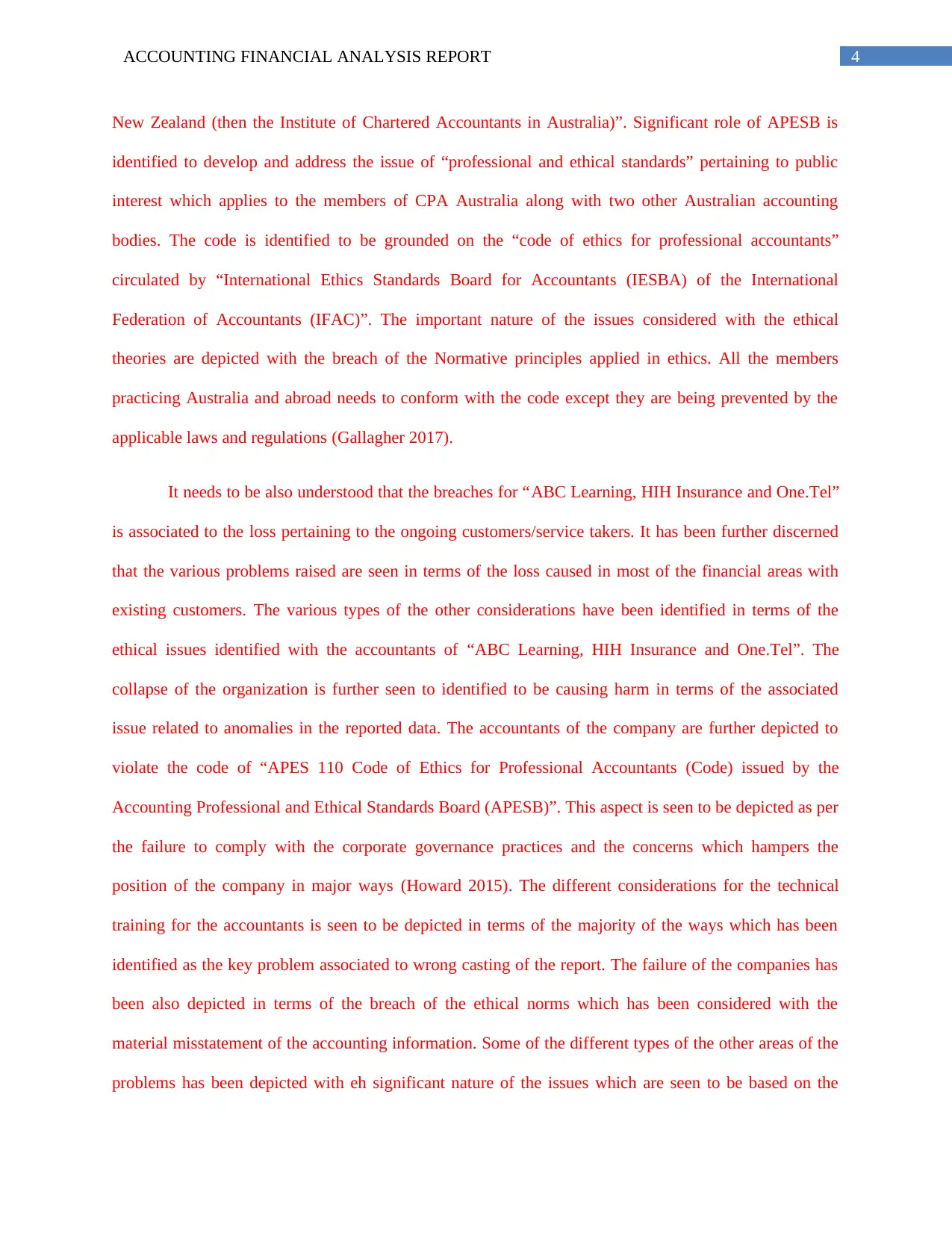
4ACCOUNTING FINANCIAL ANALYSIS REPORT
New Zealand (then the Institute of Chartered Accountants in Australia)”. Significant role of APESB is
identified to develop and address the issue of “professional and ethical standards” pertaining to public
interest which applies to the members of CPA Australia along with two other Australian accounting
bodies. The code is identified to be grounded on the “code of ethics for professional accountants”
circulated by “International Ethics Standards Board for Accountants (IESBA) of the International
Federation of Accountants (IFAC)”. The important nature of the issues considered with the ethical
theories are depicted with the breach of the Normative principles applied in ethics. All the members
practicing Australia and abroad needs to conform with the code except they are being prevented by the
applicable laws and regulations (Gallagher 2017).
It needs to be also understood that the breaches for “ABC Learning, HIH Insurance and One.Tel”
is associated to the loss pertaining to the ongoing customers/service takers. It has been further discerned
that the various problems raised are seen in terms of the loss caused in most of the financial areas with
existing customers. The various types of the other considerations have been identified in terms of the
ethical issues identified with the accountants of “ABC Learning, HIH Insurance and One.Tel”. The
collapse of the organization is further seen to identified to be causing harm in terms of the associated
issue related to anomalies in the reported data. The accountants of the company are further depicted to
violate the code of “APES 110 Code of Ethics for Professional Accountants (Code) issued by the
Accounting Professional and Ethical Standards Board (APESB)”. This aspect is seen to be depicted as per
the failure to comply with the corporate governance practices and the concerns which hampers the
position of the company in major ways (Howard 2015). The different considerations for the technical
training for the accountants is seen to be depicted in terms of the majority of the ways which has been
identified as the key problem associated to wrong casting of the report. The failure of the companies has
been also depicted in terms of the breach of the ethical norms which has been considered with the
material misstatement of the accounting information. Some of the different types of the other areas of the
problems has been depicted with eh significant nature of the issues which are seen to be based on the
New Zealand (then the Institute of Chartered Accountants in Australia)”. Significant role of APESB is
identified to develop and address the issue of “professional and ethical standards” pertaining to public
interest which applies to the members of CPA Australia along with two other Australian accounting
bodies. The code is identified to be grounded on the “code of ethics for professional accountants”
circulated by “International Ethics Standards Board for Accountants (IESBA) of the International
Federation of Accountants (IFAC)”. The important nature of the issues considered with the ethical
theories are depicted with the breach of the Normative principles applied in ethics. All the members
practicing Australia and abroad needs to conform with the code except they are being prevented by the
applicable laws and regulations (Gallagher 2017).
It needs to be also understood that the breaches for “ABC Learning, HIH Insurance and One.Tel”
is associated to the loss pertaining to the ongoing customers/service takers. It has been further discerned
that the various problems raised are seen in terms of the loss caused in most of the financial areas with
existing customers. The various types of the other considerations have been identified in terms of the
ethical issues identified with the accountants of “ABC Learning, HIH Insurance and One.Tel”. The
collapse of the organization is further seen to identified to be causing harm in terms of the associated
issue related to anomalies in the reported data. The accountants of the company are further depicted to
violate the code of “APES 110 Code of Ethics for Professional Accountants (Code) issued by the
Accounting Professional and Ethical Standards Board (APESB)”. This aspect is seen to be depicted as per
the failure to comply with the corporate governance practices and the concerns which hampers the
position of the company in major ways (Howard 2015). The different considerations for the technical
training for the accountants is seen to be depicted in terms of the majority of the ways which has been
identified as the key problem associated to wrong casting of the report. The failure of the companies has
been also depicted in terms of the breach of the ethical norms which has been considered with the
material misstatement of the accounting information. Some of the different types of the other areas of the
problems has been depicted with eh significant nature of the issues which are seen to be based on the
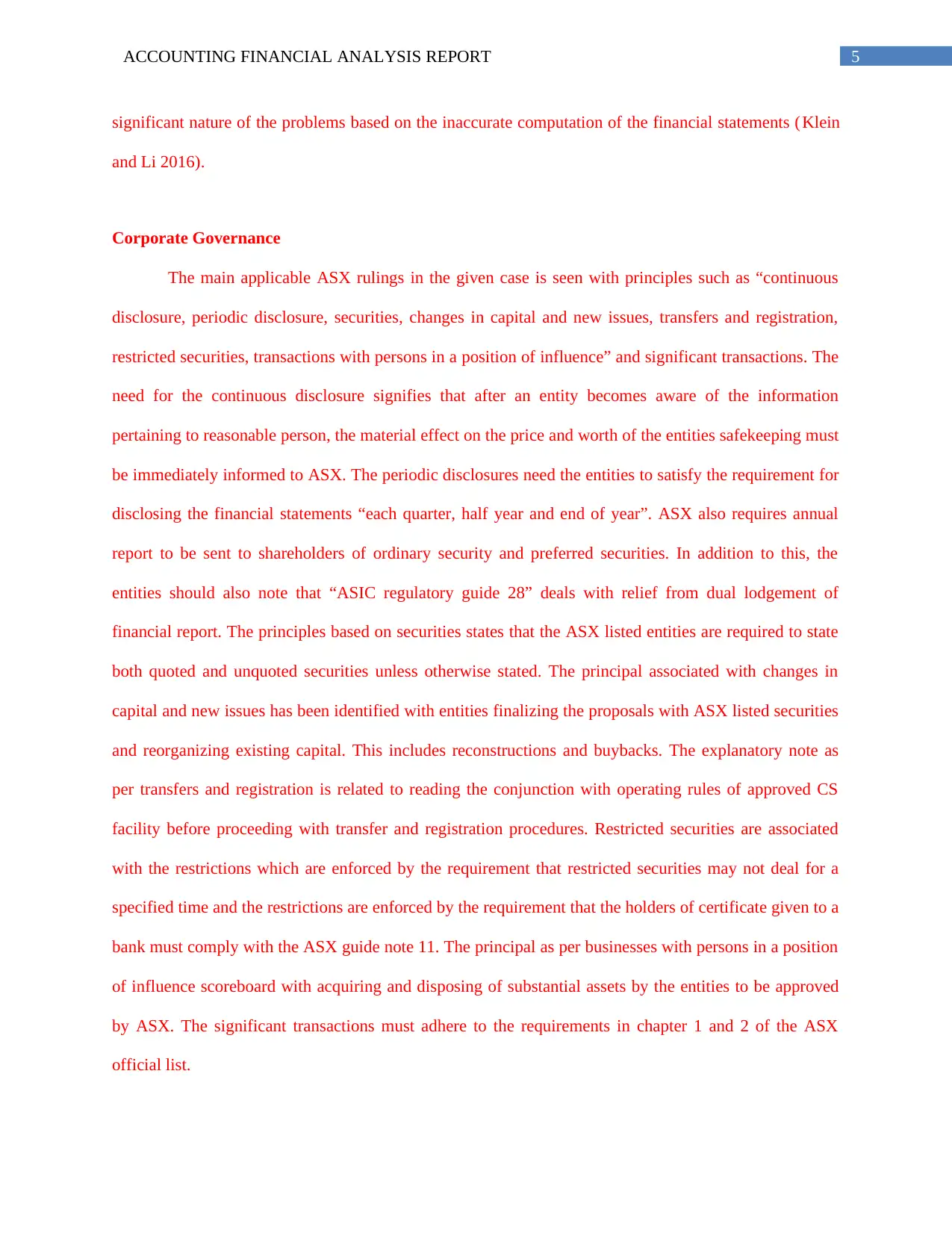
5ACCOUNTING FINANCIAL ANALYSIS REPORT
significant nature of the problems based on the inaccurate computation of the financial statements ( Klein
and Li 2016).
Corporate Governance
The main applicable ASX rulings in the given case is seen with principles such as “continuous
disclosure, periodic disclosure, securities, changes in capital and new issues, transfers and registration,
restricted securities, transactions with persons in a position of influence” and significant transactions. The
need for the continuous disclosure signifies that after an entity becomes aware of the information
pertaining to reasonable person, the material effect on the price and worth of the entities safekeeping must
be immediately informed to ASX. The periodic disclosures need the entities to satisfy the requirement for
disclosing the financial statements “each quarter, half year and end of year”. ASX also requires annual
report to be sent to shareholders of ordinary security and preferred securities. In addition to this, the
entities should also note that “ASIC regulatory guide 28” deals with relief from dual lodgement of
financial report. The principles based on securities states that the ASX listed entities are required to state
both quoted and unquoted securities unless otherwise stated. The principal associated with changes in
capital and new issues has been identified with entities finalizing the proposals with ASX listed securities
and reorganizing existing capital. This includes reconstructions and buybacks. The explanatory note as
per transfers and registration is related to reading the conjunction with operating rules of approved CS
facility before proceeding with transfer and registration procedures. Restricted securities are associated
with the restrictions which are enforced by the requirement that restricted securities may not deal for a
specified time and the restrictions are enforced by the requirement that the holders of certificate given to a
bank must comply with the ASX guide note 11. The principal as per businesses with persons in a position
of influence scoreboard with acquiring and disposing of substantial assets by the entities to be approved
by ASX. The significant transactions must adhere to the requirements in chapter 1 and 2 of the ASX
official list.
significant nature of the problems based on the inaccurate computation of the financial statements ( Klein
and Li 2016).
Corporate Governance
The main applicable ASX rulings in the given case is seen with principles such as “continuous
disclosure, periodic disclosure, securities, changes in capital and new issues, transfers and registration,
restricted securities, transactions with persons in a position of influence” and significant transactions. The
need for the continuous disclosure signifies that after an entity becomes aware of the information
pertaining to reasonable person, the material effect on the price and worth of the entities safekeeping must
be immediately informed to ASX. The periodic disclosures need the entities to satisfy the requirement for
disclosing the financial statements “each quarter, half year and end of year”. ASX also requires annual
report to be sent to shareholders of ordinary security and preferred securities. In addition to this, the
entities should also note that “ASIC regulatory guide 28” deals with relief from dual lodgement of
financial report. The principles based on securities states that the ASX listed entities are required to state
both quoted and unquoted securities unless otherwise stated. The principal associated with changes in
capital and new issues has been identified with entities finalizing the proposals with ASX listed securities
and reorganizing existing capital. This includes reconstructions and buybacks. The explanatory note as
per transfers and registration is related to reading the conjunction with operating rules of approved CS
facility before proceeding with transfer and registration procedures. Restricted securities are associated
with the restrictions which are enforced by the requirement that restricted securities may not deal for a
specified time and the restrictions are enforced by the requirement that the holders of certificate given to a
bank must comply with the ASX guide note 11. The principal as per businesses with persons in a position
of influence scoreboard with acquiring and disposing of substantial assets by the entities to be approved
by ASX. The significant transactions must adhere to the requirements in chapter 1 and 2 of the ASX
official list.
⊘ This is a preview!⊘
Do you want full access?
Subscribe today to unlock all pages.

Trusted by 1+ million students worldwide
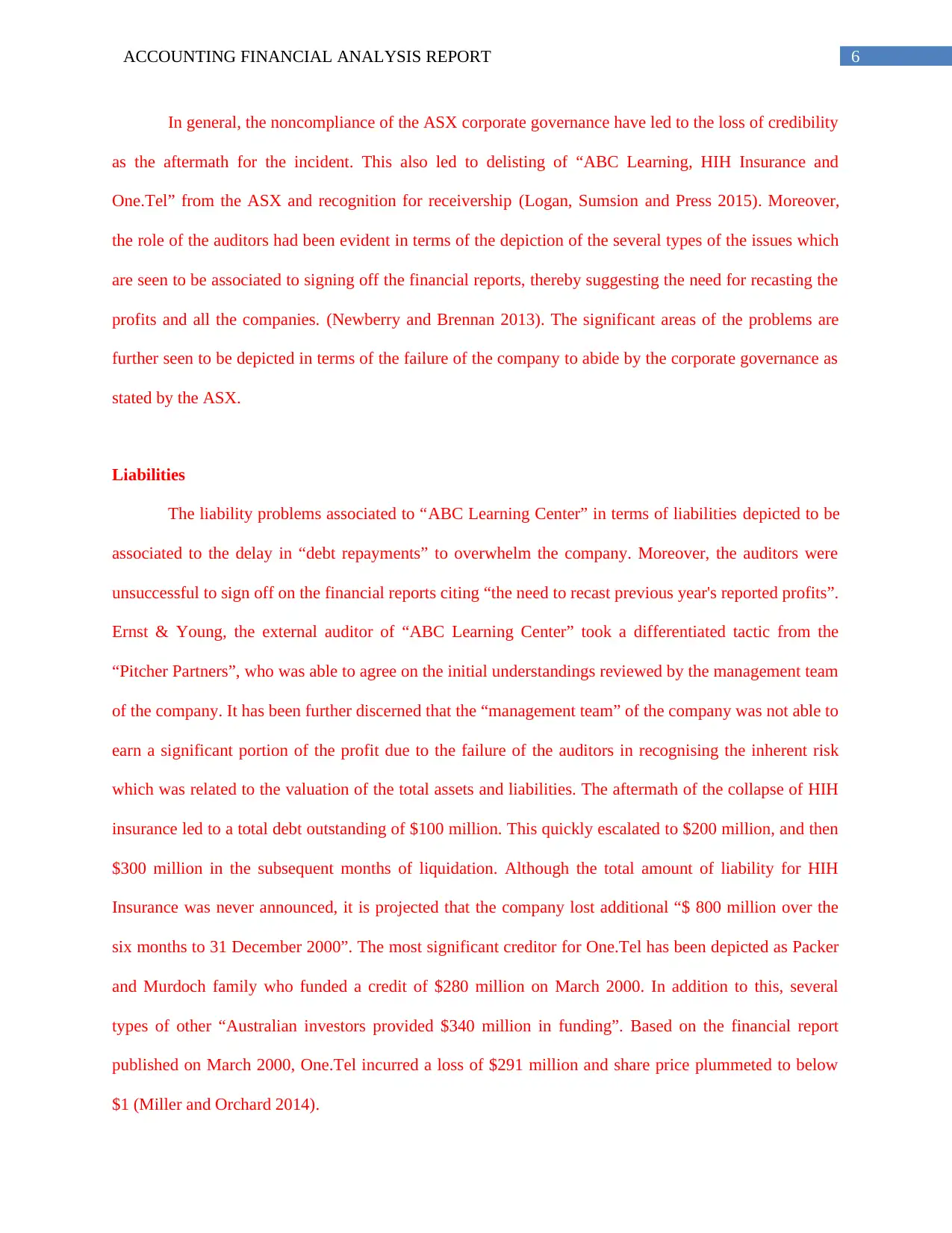
6ACCOUNTING FINANCIAL ANALYSIS REPORT
In general, the noncompliance of the ASX corporate governance have led to the loss of credibility
as the aftermath for the incident. This also led to delisting of “ABC Learning, HIH Insurance and
One.Tel” from the ASX and recognition for receivership (Logan, Sumsion and Press 2015). Moreover,
the role of the auditors had been evident in terms of the depiction of the several types of the issues which
are seen to be associated to signing off the financial reports, thereby suggesting the need for recasting the
profits and all the companies. (Newberry and Brennan 2013). The significant areas of the problems are
further seen to be depicted in terms of the failure of the company to abide by the corporate governance as
stated by the ASX.
Liabilities
The liability problems associated to “ABC Learning Center” in terms of liabilities depicted to be
associated to the delay in “debt repayments” to overwhelm the company. Moreover, the auditors were
unsuccessful to sign off on the financial reports citing “the need to recast previous year's reported profits”.
Ernst & Young, the external auditor of “ABC Learning Center” took a differentiated tactic from the
“Pitcher Partners”, who was able to agree on the initial understandings reviewed by the management team
of the company. It has been further discerned that the “management team” of the company was not able to
earn a significant portion of the profit due to the failure of the auditors in recognising the inherent risk
which was related to the valuation of the total assets and liabilities. The aftermath of the collapse of HIH
insurance led to a total debt outstanding of $100 million. This quickly escalated to $200 million, and then
$300 million in the subsequent months of liquidation. Although the total amount of liability for HIH
Insurance was never announced, it is projected that the company lost additional “$ 800 million over the
six months to 31 December 2000”. The most significant creditor for One.Tel has been depicted as Packer
and Murdoch family who funded a credit of $280 million on March 2000. In addition to this, several
types of other “Australian investors provided $340 million in funding”. Based on the financial report
published on March 2000, One.Tel incurred a loss of $291 million and share price plummeted to below
$1 (Miller and Orchard 2014).
In general, the noncompliance of the ASX corporate governance have led to the loss of credibility
as the aftermath for the incident. This also led to delisting of “ABC Learning, HIH Insurance and
One.Tel” from the ASX and recognition for receivership (Logan, Sumsion and Press 2015). Moreover,
the role of the auditors had been evident in terms of the depiction of the several types of the issues which
are seen to be associated to signing off the financial reports, thereby suggesting the need for recasting the
profits and all the companies. (Newberry and Brennan 2013). The significant areas of the problems are
further seen to be depicted in terms of the failure of the company to abide by the corporate governance as
stated by the ASX.
Liabilities
The liability problems associated to “ABC Learning Center” in terms of liabilities depicted to be
associated to the delay in “debt repayments” to overwhelm the company. Moreover, the auditors were
unsuccessful to sign off on the financial reports citing “the need to recast previous year's reported profits”.
Ernst & Young, the external auditor of “ABC Learning Center” took a differentiated tactic from the
“Pitcher Partners”, who was able to agree on the initial understandings reviewed by the management team
of the company. It has been further discerned that the “management team” of the company was not able to
earn a significant portion of the profit due to the failure of the auditors in recognising the inherent risk
which was related to the valuation of the total assets and liabilities. The aftermath of the collapse of HIH
insurance led to a total debt outstanding of $100 million. This quickly escalated to $200 million, and then
$300 million in the subsequent months of liquidation. Although the total amount of liability for HIH
Insurance was never announced, it is projected that the company lost additional “$ 800 million over the
six months to 31 December 2000”. The most significant creditor for One.Tel has been depicted as Packer
and Murdoch family who funded a credit of $280 million on March 2000. In addition to this, several
types of other “Australian investors provided $340 million in funding”. Based on the financial report
published on March 2000, One.Tel incurred a loss of $291 million and share price plummeted to below
$1 (Miller and Orchard 2014).
Paraphrase This Document
Need a fresh take? Get an instant paraphrase of this document with our AI Paraphraser
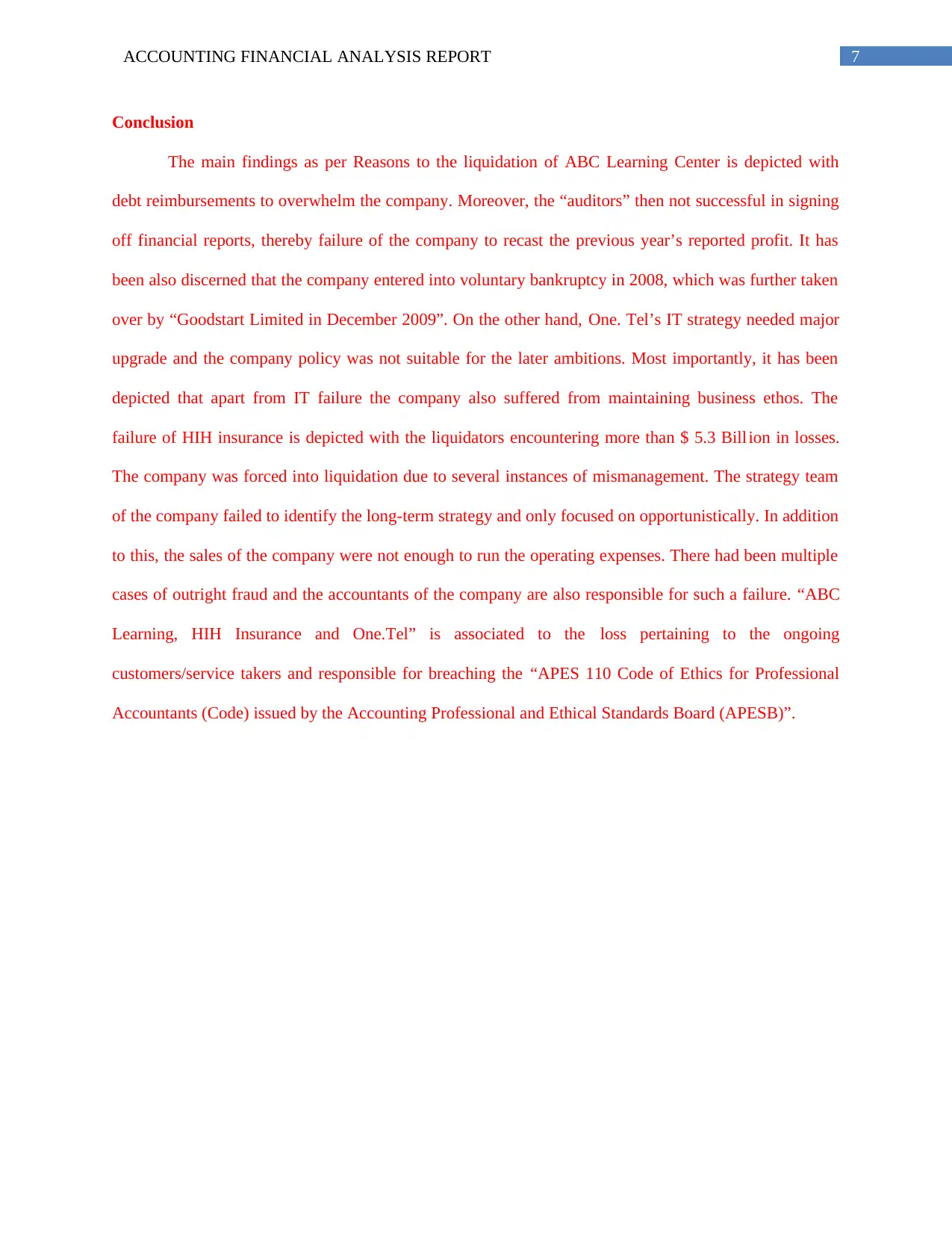
7ACCOUNTING FINANCIAL ANALYSIS REPORT
Conclusion
The main findings as per Reasons to the liquidation of ABC Learning Center is depicted with
debt reimbursements to overwhelm the company. Moreover, the “auditors” then not successful in signing
off financial reports, thereby failure of the company to recast the previous year’s reported profit. It has
been also discerned that the company entered into voluntary bankruptcy in 2008, which was further taken
over by “Goodstart Limited in December 2009”. On the other hand, One. Tel’s IT strategy needed major
upgrade and the company policy was not suitable for the later ambitions. Most importantly, it has been
depicted that apart from IT failure the company also suffered from maintaining business ethos. The
failure of HIH insurance is depicted with the liquidators encountering more than $ 5.3 Bill ion in losses.
The company was forced into liquidation due to several instances of mismanagement. The strategy team
of the company failed to identify the long-term strategy and only focused on opportunistically. In addition
to this, the sales of the company were not enough to run the operating expenses. There had been multiple
cases of outright fraud and the accountants of the company are also responsible for such a failure. “ABC
Learning, HIH Insurance and One.Tel” is associated to the loss pertaining to the ongoing
customers/service takers and responsible for breaching the “APES 110 Code of Ethics for Professional
Accountants (Code) issued by the Accounting Professional and Ethical Standards Board (APESB)”.
Conclusion
The main findings as per Reasons to the liquidation of ABC Learning Center is depicted with
debt reimbursements to overwhelm the company. Moreover, the “auditors” then not successful in signing
off financial reports, thereby failure of the company to recast the previous year’s reported profit. It has
been also discerned that the company entered into voluntary bankruptcy in 2008, which was further taken
over by “Goodstart Limited in December 2009”. On the other hand, One. Tel’s IT strategy needed major
upgrade and the company policy was not suitable for the later ambitions. Most importantly, it has been
depicted that apart from IT failure the company also suffered from maintaining business ethos. The
failure of HIH insurance is depicted with the liquidators encountering more than $ 5.3 Bill ion in losses.
The company was forced into liquidation due to several instances of mismanagement. The strategy team
of the company failed to identify the long-term strategy and only focused on opportunistically. In addition
to this, the sales of the company were not enough to run the operating expenses. There had been multiple
cases of outright fraud and the accountants of the company are also responsible for such a failure. “ABC
Learning, HIH Insurance and One.Tel” is associated to the loss pertaining to the ongoing
customers/service takers and responsible for breaching the “APES 110 Code of Ethics for Professional
Accountants (Code) issued by the Accounting Professional and Ethical Standards Board (APESB)”.
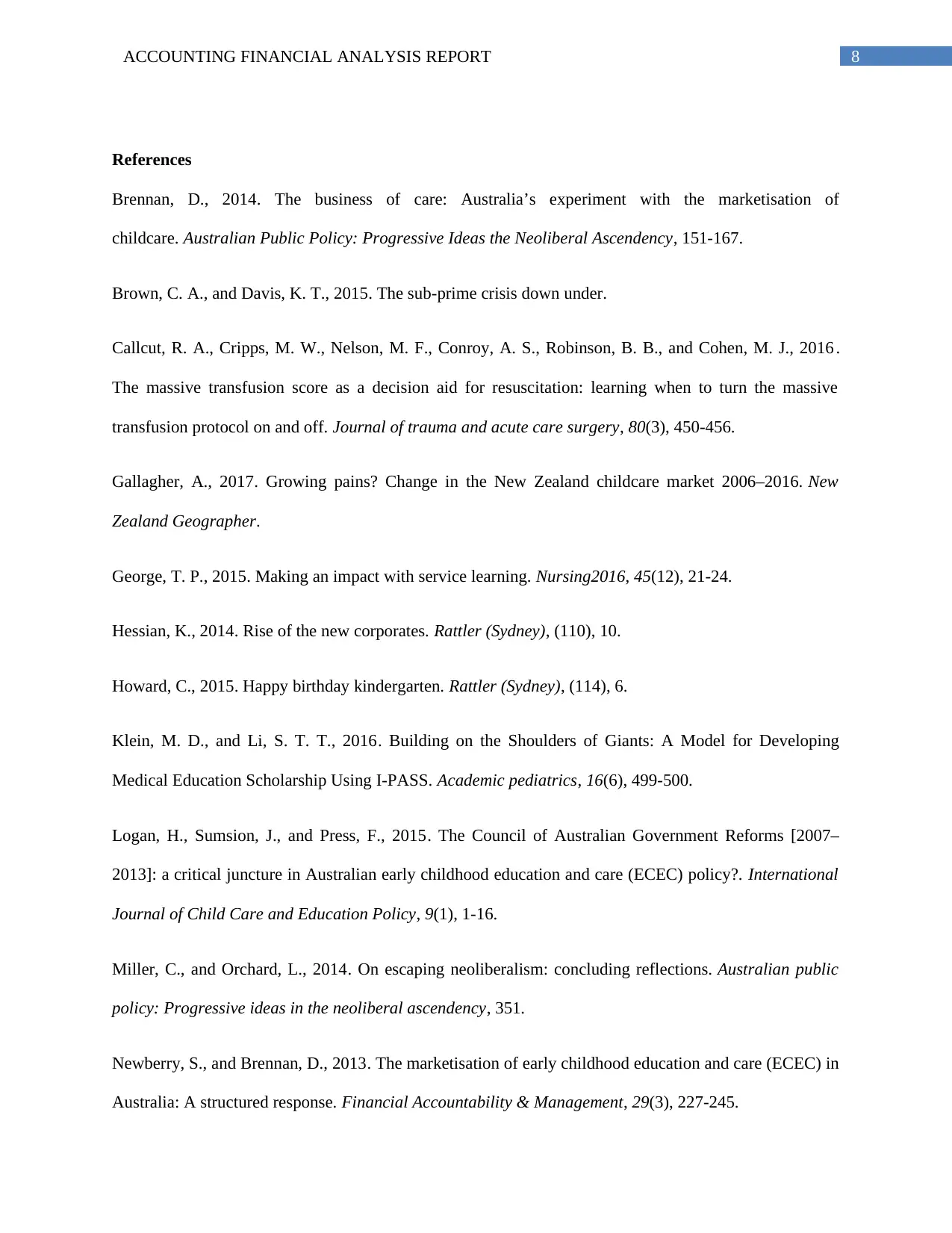
8ACCOUNTING FINANCIAL ANALYSIS REPORT
References
Brennan, D., 2014. The business of care: Australia’s experiment with the marketisation of
childcare. Australian Public Policy: Progressive Ideas the Neoliberal Ascendency, 151-167.
Brown, C. A., and Davis, K. T., 2015. The sub-prime crisis down under.
Callcut, R. A., Cripps, M. W., Nelson, M. F., Conroy, A. S., Robinson, B. B., and Cohen, M. J., 2016 .
The massive transfusion score as a decision aid for resuscitation: learning when to turn the massive
transfusion protocol on and off. Journal of trauma and acute care surgery, 80(3), 450-456.
Gallagher, A., 2017. Growing pains? Change in the New Zealand childcare market 2006–2016. New
Zealand Geographer.
George, T. P., 2015. Making an impact with service learning. Nursing2016, 45(12), 21-24.
Hessian, K., 2014. Rise of the new corporates. Rattler (Sydney), (110), 10.
Howard, C., 2015. Happy birthday kindergarten. Rattler (Sydney), (114), 6.
Klein, M. D., and Li, S. T. T., 2016. Building on the Shoulders of Giants: A Model for Developing
Medical Education Scholarship Using I-PASS. Academic pediatrics, 16(6), 499-500.
Logan, H., Sumsion, J., and Press, F., 2015. The Council of Australian Government Reforms [2007–
2013]: a critical juncture in Australian early childhood education and care (ECEC) policy?. International
Journal of Child Care and Education Policy, 9(1), 1-16.
Miller, C., and Orchard, L., 2014. On escaping neoliberalism: concluding reflections. Australian public
policy: Progressive ideas in the neoliberal ascendency, 351.
Newberry, S., and Brennan, D., 2013. The marketisation of early childhood education and care (ECEC) in
Australia: A structured response. Financial Accountability & Management, 29(3), 227-245.
References
Brennan, D., 2014. The business of care: Australia’s experiment with the marketisation of
childcare. Australian Public Policy: Progressive Ideas the Neoliberal Ascendency, 151-167.
Brown, C. A., and Davis, K. T., 2015. The sub-prime crisis down under.
Callcut, R. A., Cripps, M. W., Nelson, M. F., Conroy, A. S., Robinson, B. B., and Cohen, M. J., 2016 .
The massive transfusion score as a decision aid for resuscitation: learning when to turn the massive
transfusion protocol on and off. Journal of trauma and acute care surgery, 80(3), 450-456.
Gallagher, A., 2017. Growing pains? Change in the New Zealand childcare market 2006–2016. New
Zealand Geographer.
George, T. P., 2015. Making an impact with service learning. Nursing2016, 45(12), 21-24.
Hessian, K., 2014. Rise of the new corporates. Rattler (Sydney), (110), 10.
Howard, C., 2015. Happy birthday kindergarten. Rattler (Sydney), (114), 6.
Klein, M. D., and Li, S. T. T., 2016. Building on the Shoulders of Giants: A Model for Developing
Medical Education Scholarship Using I-PASS. Academic pediatrics, 16(6), 499-500.
Logan, H., Sumsion, J., and Press, F., 2015. The Council of Australian Government Reforms [2007–
2013]: a critical juncture in Australian early childhood education and care (ECEC) policy?. International
Journal of Child Care and Education Policy, 9(1), 1-16.
Miller, C., and Orchard, L., 2014. On escaping neoliberalism: concluding reflections. Australian public
policy: Progressive ideas in the neoliberal ascendency, 351.
Newberry, S., and Brennan, D., 2013. The marketisation of early childhood education and care (ECEC) in
Australia: A structured response. Financial Accountability & Management, 29(3), 227-245.
⊘ This is a preview!⊘
Do you want full access?
Subscribe today to unlock all pages.

Trusted by 1+ million students worldwide

9ACCOUNTING FINANCIAL ANALYSIS REPORT
Nyland, B., and Ng, J., 2016. International perspectives on early childhood curriculum changes in
Singapore and Australia. European Early Childhood Education Research Journal, 24(3), 465-476.
Nyland, B., and Ng, J., 2016. International perspectives on early childhood curriculum changes in
Singapore and Australia. European Early Childhood Education Research Journal, 24(3), 465-476.
1 out of 10
Related Documents
Your All-in-One AI-Powered Toolkit for Academic Success.
+13062052269
info@desklib.com
Available 24*7 on WhatsApp / Email
![[object Object]](/_next/static/media/star-bottom.7253800d.svg)
Unlock your academic potential
Copyright © 2020–2025 A2Z Services. All Rights Reserved. Developed and managed by ZUCOL.





